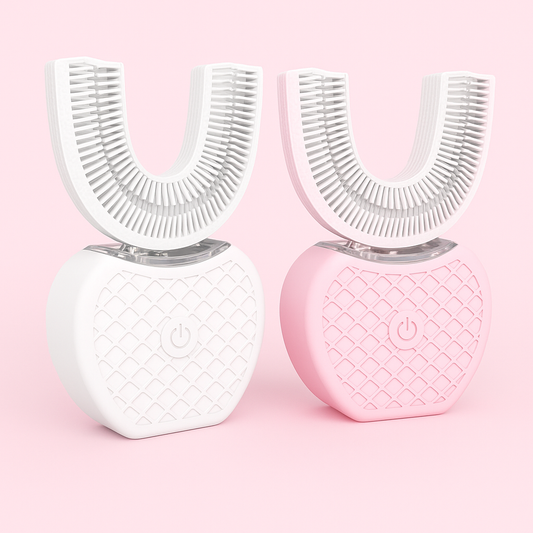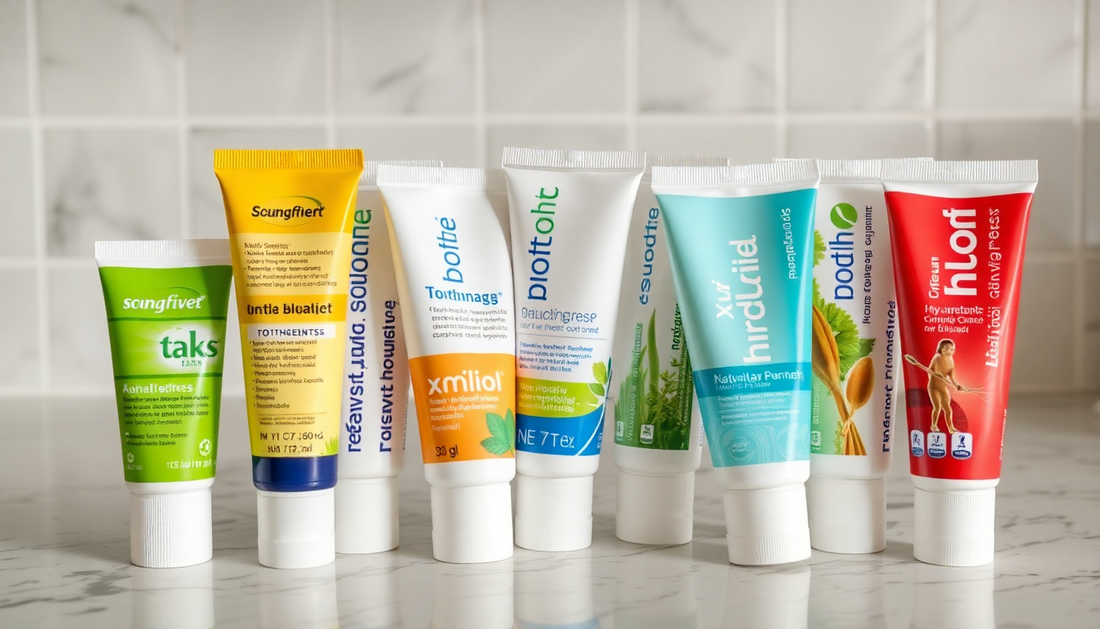Introduction
In 2025, consumers are more ingredient-savvy than ever. Search demand for terms like "good whitening toothpaste," "toothpaste without fluoride," "toothpaste with xylitol," and "best toothpaste for whiter teeth" continues to grow. But whitening isn’t just about aggressive abrasion — it’s about balanced formulations that brighten teeth while protecting enamel and supporting gum health. This in-depth guide breaks down how whitening toothpastes work, what to avoid, and how fluoride-free options with xylitol and niacinamide can deliver a healthier, brighter smile.
How Whitening Toothpastes Work: Beyond Abrasion
Whitening toothpastes remove or reduce extrinsic (surface) stains via two main mechanisms:
- Mechanical removal: mild polishing agents (silica, calcium carbonate) gently scrub stains away.
- Chemical action: low concentrations of peroxide, enzymes, or anti-stain polymers break down or prevent stain re-deposition.
Overly abrasive pastes can initially make teeth look whiter by eroding enamel, which is harmful long-term. The best whitening toothpaste combines effective but low-to-moderate abrasion with chemical and biological actives that target stains without sacrificing enamel integrity.
Why Consider Fluoride-Free Formulations?
Fluoride is a proven cavity-prevention agent. However, some people choose fluoride-free options for personal, medical, or cultural reasons. If you search for "toothpaste without fluoride" or "fluoride toothpaste free," you’ll find formulations that compensate with alternative strategies:
- Remineralizing agents like hydroxyapatite or calcium phosphates that rebuild enamel structure.
- Xylitol to reduce cariogenic bacteria and lower cavity risk.
- Anti-inflammatory ingredients such as niacinamide to support gum health.
Choosing a fluoride-free toothpaste can be safe if the product includes credible alternatives to support enamel and oral health. If you have a high risk of cavities, consult your dentist before switching.
Xylitol: A Smart Addition for Healthier, Whiter Smiles
Xylitol is a sugar alcohol that taste-wise mimics sugar but disrupts the metabolism of cavity-causing bacteria such as Streptococcus mutans. Benefits of toothpaste with xylitol include:
- Reduced plaque accumulation, which helps prevent the build-up of stain-bearing film.
- Lowered acid production in the mouth, supporting enamel preservation.
- Synergy with other oral-care products: using xylitol gum or mints after meals complements a toothpaste that contains xylitol.
If your goal is a truly "toothpaste that whitens teeth" while protecting long-term oral health, prioritize formulas listing xylitol among the top ingredients.
Niacinamide: An Emerging Support for Gum & Smile Health
Niacinamide (vitamin B3) is better known in skincare, but its anti-inflammatory and barrier-supporting effects can be beneficial in oral care too. Expected benefits in toothpaste formulations include:
- Reduction in gum inflammation and improved gum appearance, which can make teeth look healthier and more prominent.
- Potential to soothe sensitivity-related discomfort that can arise with some whitening routines.
While niacinamide is not a direct bleaching agent, its role in gum health contributes to a brighter-looking smile and complements other whitening mechanisms.
Balancing Abrasion, Chemistry, and Remineralization
When evaluating whitening options, pay attention to the following technical points:
- RDA (Relative Dentin Abrasion): Aim for toothpastes with low-to-moderate RDA values (preferably under 100). Low RDA reduces long-term enamel wear.
- Polishing agents: Look for controlled silica or calcium carbonate that are effective but not overly gritty.
- Peroxide content: Mild peroxide levels can help chemically lift stains; expect gradual improvement in OTC pastes rather than instant results.
- Remineralizers: In fluoride-free formulas, seek hydroxyapatite, calcium phosphates, or CPP-ACP to restore enamel minerals.
Shopping Guide: How to Pick the Best Toothpaste Whitening Teeth Safely
Use this checklist when deciding between products labeled "toothpaste whitening best" or "best toothpaste for whiter teeth":
- Ingredient transparency: The brand lists full ingredients and explains the role of each (e.g., xylitol as an anti-cavity agent).
- Low-to-moderate RDA: Avoid products that don’t disclose abrasion levels or that claim dramatic instant whitening through scrubbing.
- Presence of supportive actives: niacinamide for gum health, hydroxyapatite or calcium phosphate for remineralization.
- Clinical or lab data: Look for third-party testing or peer-reviewed studies published by the manufacturer or independent labs.
- Customer reviews and long-term reports: Real-user feedback can flag sensitivity or enamel wear issues that aren’t obvious from the label.
- Clear labeling for fluoride-free: If you search for "toothpaste without fluoride" be sure the product explains what replaces fluoride for enamel care.
Routine Best Practices: Maximize Whitening, Minimize Risk
- Brush gently with a soft-bristled brush for two minutes, twice a day.
- Alternate: If you use a whitening toothpaste daily, consider alternating with a remineralizing or sensitive toothpaste to reduce cumulative abrasion/sensitivity.
- Rinse after pigmented foods: Rinse with water after coffee, tea, or red wine to reduce stain time on enamel.
- Use xylitol products between meals: Xylitol gum or mints help continue anti-cavity action when brushing isn’t possible.
- Regular professional cleanings: Dental cleanings remove stubborn extrinsic stains that toothpaste can’t fully eliminate.
Frequently Asked Questions (FAQ)
Q: Will a whitening toothpaste make my teeth permanently whiter?
A: Whitening toothpaste primarily removes surface stains and can gradually lighten tooth shade. For intrinsic discoloration (internal stains), professional treatments are often required.
Q: Is fluoride-free whitening toothpaste safe?
A: Yes, when the formula includes effective remineralizers (hydroxyapatite, calcium phosphate) and antibacterial agents like xylitol. If you have high caries risk, consult your dentist first.
Q: Can niacinamide help with tooth whitening?
A: Niacinamide supports gum health and reduces inflammation, which can make teeth appear healthier and more visible. It’s not a direct bleaching agent but is beneficial in comprehensive formulations.
Q: Are more abrasive toothpastes better for whitening?
A: No. High abrasion may remove surface stains in the short term but can damage enamel and increase sensitivity, causing teeth to look darker over time as dentin becomes exposed.
Common Marketing Claims: What to Trust
Be cautious with terms like "instant whitening" or "abrasive action for quick results." Trust signals include:
- Detailed ingredient purpose and concentrations.
- Clinical studies or independent testing data (even small trials are helpful).
- Transparent RDA disclosure and safety profiles for long-term use.
Comparisons: Fluoride vs Fluoride-Free — Which Is Right for You?
Both approaches can produce whiter-looking teeth when paired with the right actives:
- Fluoride formulas: Best for people with moderate-to-high cavity risk; excellent at remineralization.
- Fluoride-free formulas: Suitable for those who prefer alternatives; choose products with hydroxyapatite or calcium phosphates and xylitol to maintain enamel health.
Red Flags to Avoid
- Vague ingredient lists or proprietary blends with no explanation.
- Products that recommend brushing more than twice a day for whitening — increased frequency can raise abrasion risk.
- High RDA values or gritty texture claims without evidence of enamel-friendly formulation.
Real-World Product Strategy: Combining Tools for a Brighter Smile
To achieve measurable whitening while protecting oral health, consider a combined approach:
- Daily: Use a low-RDA whitening toothpaste that contains xylitol and niacinamide.
- Weekly: Consider an at-home peroxide-based product or professionally supervised whitening if you need extra lift for intrinsic stains.
- Maintenance: Chew xylitol gum after meals and attend regular professional cleanings.
Where to Find Trusted Fluoride-Free Whitening Toothpaste
If you’re searching for a reliable "good whitening toothpaste" or a "toothpaste with xylitol" that is also labeled as "toothpaste without fluoride," look for brands that offer transparent ingredient lists and demonstrate clinical testing. For a convenient place to start your search, you can explore curated options like the "best toothpaste for whiter teeth" and specialized "toothpaste with xylitol" selections on Havana Body’s website.
Summary: Choosing a Toothpaste That Whitens Safely
Effective whitening is a balance: gentle mechanical cleaning, targeted chemical actives, antibacterial support from xylitol, and gum health support from niacinamide. Whether you choose a fluoride or fluoride-free paste, prioritize low-to-moderate abrasion, remineralizing agents, and clinical backing to protect enamel while brightening your smile.
Final Recommendation & Call to Action
If you want to explore thoughtfully formulated, fluoride-free whitening options that prioritize both appearance and oral health, check out Havana Body’s curated picks for toothpaste that whitens teeth safely. Browse their selection of products labeled among the "best toothpaste whitening teeth" and find specialized "toothpaste without fluoride" and "toothpaste that whitens teeth" formulations. Ready for a brighter smile? Visit Havana Body now to discover and purchase the products that match your needs: Buy Havana Body products.
Remember: before making significant changes to your oral-care routine, especially if you have sensitive teeth, active decay, or gum disease, consult your dentist for personalized guidance.


